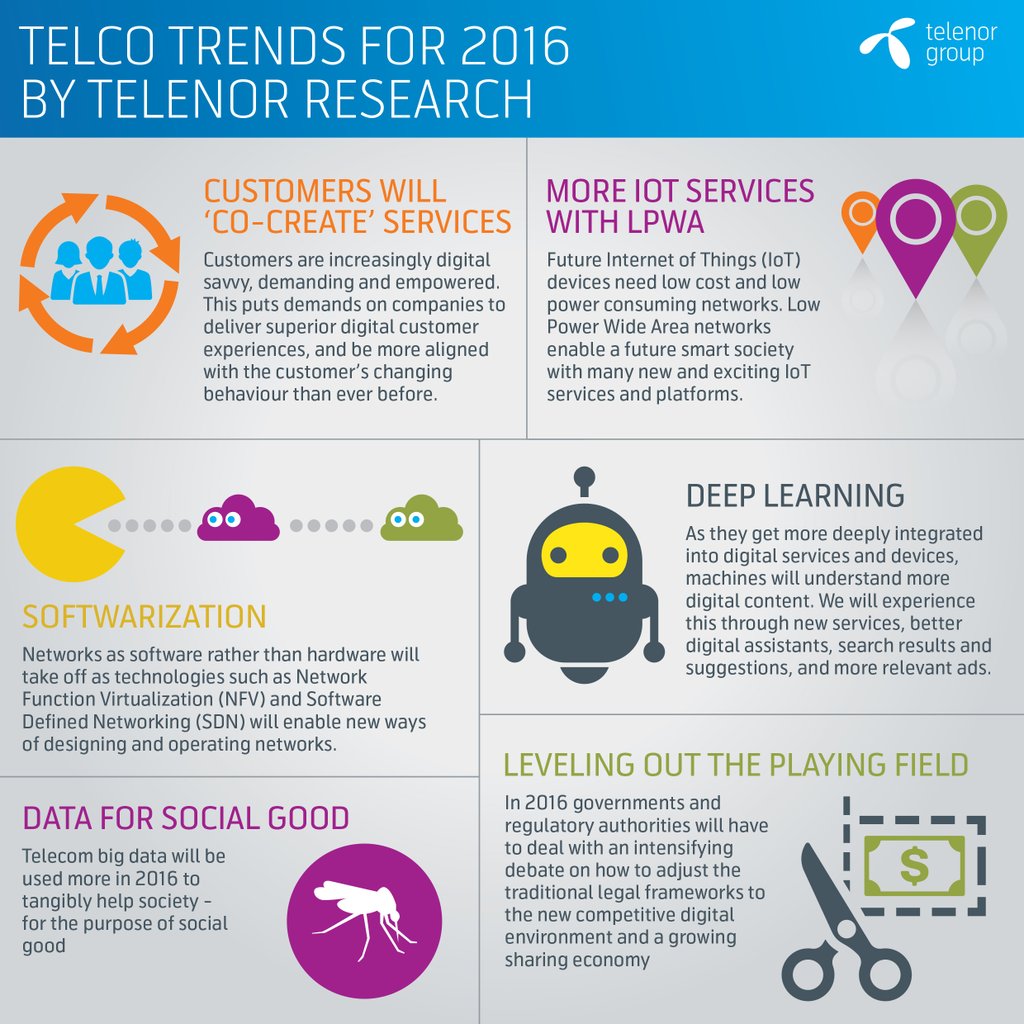27 January, 2016
ETNO Think Digital blog post: Machines with a deeper understanding of digital content, big data as a solution to addressing greater societal challenges – telecom trends in 2016
Bjørn Taale Sandberg, Senior Vice President and Head of Telenor Research outlines his best guess at the six most important trending areas of 2016. #ThinkDigital
The telecoms sector is the place to be this year – I can feel the buzzing energy every day of my life. At Telenor, my colleagues and I have carried out some research to identify a few of the ongoing trends that will develop throughout 2016. The outcome depicts an exciting, fast-paced journey towards full digitisation, stimulated by customer expectations, an evolving competition landscape, regulatory reform and accelerating technological change.
Our research focuses on six trends that we believe will be important in 2016, not because they are new, but because this is the year in which you will notice them and feel the change.
These changes are already palpable today. Just think about everything you use your smartphone for while on-the-go: Buying tickets, clothes, books, ordering takeaway, monitoring your heart rate, getting GPS directions or storing your boarding pass on the way to the airport… Or as Kate Bevan recently described in her FT article: “Smart kettles, fridges that keep tabs on when the milk is going off, tweeting catflaps, connected keyless locks…” The possibilities are endless. And as these expand, so will our dependence on mobile technologies.
The increase in digitisation will transform all aspects of the telecom industry creating new opportunities for the sector. Here are the key global telecom trends that my colleagues and I at Telenor Research have hand-picked for you to have a ‘digital think’ about as the first month of 2016 comes to an end.
Customers will co-create services
With increasingly digitally-savvy, demanding and empowered customers, companies are expected to deliver superior digital experiences and to be more aligned with customer expectations than ever before. In 2016, businesses will focus on involving customers in a more systematic way than in the past during the early stages of service development. In this fast-paced business environment, service design has become a globally recognised competitive capability, key to the creation of superior customer value.
Big data will help address greater societal challenges
What does this mean you might ask? Let me explain with an example from our Telenor Branch in Pakistan where we analysed anonymous and aggregated data to better understand the impact of human mobility on the spreading of dengue fever in the country. The result is concrete “heat maps” that help the authorities locate higher risk zones and thus send aid.
More activities of this kind are crucial as they save lives. Big companies that collect data have the capacity to use this data when addressing greater societal challenges. We believe that this direct correlation between data and solving social issues will become more tangible in 2016 as the cooperation between public and private sectors increases. In this context, it is vital to get it right in terms of privacy and maintaining the anonymity of said data.
Softwarisation
2016 will see the emergence of many innovative services thanks to the deployment of new technologies such as Network Function Virtualisation (NFV) and Software Defined Networking (SDN). The trend will have a huge impact on actors in the telecommunications industry including vendors, operators and other service providers.
These technologies can give operators the agility and flexibility to deliver new, and improved existing services much faster than before and to improve their operational efficiency through automation. Here we will see a transformation in telecom operators as networks and IT converge.
Machines will understand more Digital Content
We have witnessed continuous breakthroughs in what is known as ‘Artificial Intelligence’ over the past few years and 2016 will be no exception. Today, machines are able to recognise speech, translate text and answer questions and as machine learning techniques become more sophisticated they will become more integrated in our everyday devices. Users will find that their digital services and devices will be able to better understand digital content, will offer better assistance, better search results and suggestions, more relevant ads and will therefore be more tailored to their needs.
The Internet of Things will continue to boom
As more and more objects become connected, the need for low cost, low power consuming networks will increase. So-called Low Power Wide Area (LPWA) networks hold the answer to a future smart society and we believe that many new and exciting Internet of Things services and platforms will see the light of day in 2016 thanks to the large-scale deployment of LPWA technologies such as Long Term Evolution for Machines (LTE-M), Narrowband Internet of Things (NB-IoT) and LoRa (Long Range).
Levelling out the playing field in the Digital Economy
2016 will be a year of regulatory reform as governments and regulatory authorities adjust the current legal framework to fit the new competitive digital environment and a growing shared economy. It is clear that many new firms have developed services, products and business models that directly compete with the services provided by traditional actors – Uber, Airbnb, Whatsapp to name a few. The legal framework has not yet caught up with these rapid developments. For instance, traditional communication service providers are subject to sector specific rules on privacy and contract terms that internet based providers of communication services do not have to comply with. We expect such imbalances to be fully analysed in 2016 as policymakers and regulators discuss concrete ideas on how to adapt to the new digital society.
By Bjørn Taale Sandberg for ETNO #ThinkDigital, 26.01.2016
***
Bjørn Taale Sandberg, Senior Vice President and Head of Telenor Research, Telenor
Bjørn Taale Sandberg joined Telenor in 2000 and is Senior Vice President and Head of Telenor Research. Previously, he served as CEO of AeroMobile Ltd, based in the UK, Chief Marketing Officer in Telenor Pakistan and Head of Strategy for Telenor Mobile Communications.
Sandberg has a Master in Computer Science from the University of Oslo and a Master of Management from the Norwegian Business School (BI).
Telenor Research is Telenor’s internal scientific research unit. The unit works with Telenor’s 13 subsidiaries and external academic and industry organisations on research into regulatory, competition, customer, technology and organisational development issues relevant to Telenor and the industry. Telenor Research publishes regularly in scientific journals and functions as an advisor to the top management.


